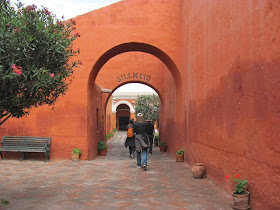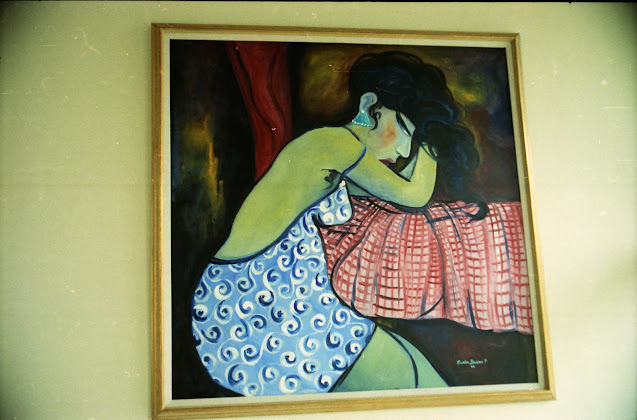Truly enlightened New Westerners, both liberal and conservative, once they cut through all the national political crap, agreed the New West had come to its senses when it decided to build a border wall, not on its southern border, as most Americans assumed, but at the eastern border, separating the region, physically and existentially, from the rest the country, including Texas, which New Westerners agreed was better aligned with the Deep South, sacrificing so many lambs to the wolves.
After a decade of studies by major government agencies, international corporations, major research universities, NGOs, and environmental think tanks, it became clear the west’s problems, from crime to housing crises, unemployment, mass gentrification, and congestion were caused by the multitudes of out-of-state migrants arriving daily, the uptick during times like January 1, after the Rose Parade festivities, when the entire country froze but watched, from the televisions, as New Westerner basked in seventy-five degree temperature.
The New West, as they dubbed the region, taking a hint from the New England states, militarized its borders, turning away those out-of-state residents who failed to meet the residency requirement.
When outsider couldn’t gain legal entry, they breeched the border in makeshift boats crossing the Colorado River, trekking through New Mexico’s deserts, and taking blue highways over Colorado, Washington, and Utah's dangerous mountain passes, like in the Rocky’s (or Rockies, depending on one's spelling), to the chagrin of New Westerners, who’d had it with migrants usurping the most coveted spaces, like Pagosa Springs, CO, Raton, NM, Flagstaff, AZ, and the picturesque towns along California's Highway 49, all the way to the Canadian border.
New Western ranchers, farmers, and environmentalists complained about the uncontrolled masses of migrants illegally storming the western border, some dying in desolate locations for lack of food or water, reminiscent of the famed Donner party of the 1800s, a real humanitarian disaster.
 |
| The wall's early prototypes, reminiscent of Inca construction |
It was at this point, the western states stopped the political debates and voted to create a wall across the most traversable areas. Arizona was indignant--and divided, some wanting noting to do with a border wall, while others saw the benefits. Minor skirmishes started in Peoria, just outside Phoenix, and moved to Buckeye, where rebel forces, mostly overweight guys dressed in an assortment of unmatched military clothing and brandishing automatic weapons, tried suppressing the vote, but were subdued in Douglas, by superior New West resistance forces. After a brief battle in Old Tombstone, the rebels called it quits, the 124-degree heat-wave too much for them.
Besides, many Arizonans had such shallow roots in the state, they weren’t willing to die for the cause. Also, the Californians who had migrated to Arizona in the past thirty-years, especially the areas around Tempe and Tucson, both university towns, used their money and influence to sway political power. Ultimately, the Arizona rebels headed east, back to the “wet” states from where they’d come, originally, states like Illinois, Ohio, Michigan, Vermont, Maryland, and New Hampshire, where doctors, in the early 1900s, had advised their asthmatic ancestors the western air and sun would do wonders for the respiratory systems.
Initially, California, Colorado, New Mexico, Nevada, Oregon, Washington, and parts of Utah saw the wisdom in the creation of the "New West,” a region where the relaxed, kick-back vibe had always been ingrained in the culture, where men once wore socks with their shoes and dress-shirts under their blazers, not colorful t-shirts.
The New Westerners wanted to get back to their “work hard but rest harder,” “drugs, sex, and rock ‘n roll,” culture, so tired were they of the Calvinist, “All work no play keeps the devil away,” and “Idle hands are the Devil’s workshop,” beliefs, anathema to true westerners, even those who'd migrated from the East and Mid-West as far back as the 1800s, looking for "wide-open spaces," as the Dixie Chicks so appropriately sang, and even hippies, in the 1960s, travelled, to be "find themselves," and for the plentitude of the magic weed, and, of course, to avoid the draft. They were all "cool" and adopted western ways.
Up in Utah, the Mormons were split, referencing the song, "Should I Stay of Should I Go, but they knew the great earning power of the country was in the west, and seeing as hundreds, if not thousands of Mormon Temples already dotted the western landscape, the church fathers saw prime ground for recruiting, especially among the new Latin American and Asian immigrants working low-wage jobs. Besides, Mormons had been in the west so long, they had adopted western ways, a true “chill” attitude.
The clincher, though, was the uproar at BYU and University of Utah, two powerhouse higher education institutions in the state. Utah argued it had taken so long to become part of the Pac-12 Athletic Conference, competing with the likes of Stanford, UCLA, Washington, USC, Oregon, and Cal, it didn’t want to jeopardize its television rights and lose billions in revenue. Eventually, BYU agreed, as long as nobody challenged its right to remain Independent, not beholden to any conference, and, maybe, when the time was right, it too could join the Pac-12, which would then make it the Pac-13, and cash in on television rights.
Like the angry Arizonan rebels who turned tail and headed east, the reactionary Mormons packed-up and fled to places like Grand Rapids, Fargo, Billings, Des Moines, Lincoln, and Manchester, NY, where Joseph Smith had his first vision in the Sacred Grove in 1816, their true religious and cultural roots.
Actually, a flicker of awareness had begun when Boyle Heights Chicanos in the early 1990s lobbied the Los Angeles City Council and Board of Supervisors to change Brooklyn Avenue to Cesar Chavez, and again in 2020, when East L.A. Chicano protesters, bolstered by supporters from as far away as New Mexico, Nevada, and Colorado, amassed thousands to stop Eastern Yuppies from gentrifying the barrio, fearing it would end up like Echo Park, Highland Park, and Silverlake, then move on to gentrifying old, cool neighborhoods across the west.
 |
| Photos of the wall at Tepatitlan as an example of simple construction |
Idaho, Wyoming, Montana, the Dakotas and states farther east, lobbied Washington to send in troops, first to stop the creation of a “new west,” then to stop the construction of the border wall, but seeing nothing in the Declaration of Independence prohibited states from unifying or building border walls, the New West had every right to proceed.
Besides, precedent had been set in the 1930s when western states, using armed guards, secured their borders, prohibiting Okies and Arkies from entering the western states. Really, Uncle Sam was cool with unification as long as the individual states kept their legislatures separate. Besides, no way did the feds want regional internecine war.
Furious, most die-hard rebels who opposed the wall said the New West would fail, spreading on social media sayings like, “No man is an island” and “It takes a village,” and demonizing the region as backwards, lazy, and sneaky, which pissed off some of the more conservative farmers and ranchers who saw themselves and their employees as hardworking as anybody.
Some rebels protested at the capitol in Washington, D.C., even bringing weapons, but realized they were outmanned and outgunned when the National Guard and contingents of the 82nd Airborne confronted them, the federal government having learned a lesson from the great insurrection of the capitol way back on January 6, 2021.
Many states thought it wrong the New West could regulate its borders, allowing residency only to those who met their requirements, which, once you understood the political jargon, was mainly to have a job, a savings, housing, to mind your own business, obey the laws, and be “cool,” avoiding the angst inherent in many East Coasters, explicit in Woody Allen’s movies, the music of Lou Reed and the Velvet Underground, not to mention the Ramones, all nervous wrecks.
The Wall did cause Hollywood some concern, since so many of its big stars migrated west, like George Clooney and Johnny Depp, both Kentuckians, Brad Pitt, a Springfield, MO. boy, and Alabama’s, Courtney Cox. Even in the Latino community, people feared Floridian Pitt Bull, and New Yorkers Mark Anthony and Jennifer Lopez, might be nixed, but seeing as they'd they purchased homes in the west and claimed residency, years ago, they were admitted.
The New West wasn’t worried about its economy, not with the names of the world's richest people and corporations in residence, including the most sophisticated aerospace and weapons manufacturers, the largest naval ports, Marine and Navy bases, Air Force bases and Army posts, a host of nuclear arms sites, names like Northrup Grumman, Boeing, Vandenburg and Point Hueneme.
The New West boasted the mighty technology, agriculture, and energy sectors, so it held a lot of leverage over Washington. One California senator was heard to have stated, “We don’t need to fire a shot if attacked. We can cripple the country--no, the world, with a bank of computers and a few geeks from Silicon Valley.”
 |
| Many natural boundaries were uncovered during the wall's construction |
As the wall moved to completion, the New West continued sending more tax dollars to the nation’s capital than any other state or region in the union, especially since approximately 25 million of its residents had no legal federal documents, yet were still required to pay federal taxes and couldn’t claim tax refunds, so billions of dollars in surplus funds created a real bonus for the feds and citizens of the U.S., as well as giving the New West a boost in low-wage employees to work the vast amount of jobs westerners felt beneath them.
This was a great embarrassment to states like the Dakotas, New England, and the South, who sent practically nothing to D.C., considering their states had barely between 300,000 and a couple of million residents, yet they got their two-senator representation in Washington, the same as each New West state, California, alone, boasting nearly 40 million people. One Washington State senator who pushed for more federal representation claimed,, "Hell, man, you can drop the entire state of Montana into Imperial County."
Major corporations, which supported the New West from the beginning, bragged how California, alone, had the 5th largest economy in the world, stronger than Russia’s, but not quite a vast as Brazil’s, but together, the New West was number one, so the region didn’t fret about its entrepreneurial power or its vast resources, and claimed it had every right to protect its border from, what they called, “Culture busters, out from east of the Rockies.
Ultimately, traditional New West Republicans and Democrats joined forces, stopped listening to all attacks from cable news and political provocateurs, and realized the culture they embraced had been under assault for decades, and not from Latino migrants, people who stayed to themselves and had little to no political power, and after a generation or two, blended nicely into the rest of the population.
It was a matter of saving the West's cultural values, a fusion of music, foods, clothes, and behaviors going back to the late 1800s, when mostly Indians, Spanish, Mexicans, Chinese, Irish, and Italians fused a new culture, wide-open, kick-back and “cool.”
 |
| Satellite photo of author shows how high tech assists in border security |
The architects and engineers who designed the new border wall decided to take a page from the Intercontinental Railway that started at two opposite geographic poles, east to west, and met at Promontory, Utah on May 10, 1869. So, beginning in the north at Kaniksu National Park, on the Canada B.C. border and at Hobbs, N.M. in the south, the workers, mostly Mexican, Central Americans, and the unhoused from the cleared-out camps who were offered residency if they worked on the wall, would meet at Salt Lake City, where the Mormons lobbied to host the historic moment, a reward, of sorts, for staying loyal to the New West.
So many high mountain ranges, like the Rockies, and impassible deserts, created a natural barrier, so the border wall wasn’t as expensive or difficult to build as the old, ineffective U.S.-Mexico wall, which lay in ruins, some place west of Otay Mesa, in California. Secret high tech security centers monitor areas where the wall was impossible to build.
The New West courted all Baja, the Sea of Cortez, and large stretches of Sonora, from Agua Prieta to the beautiful beaches of Guymas, and even opened its southern borders, as the federal government looked the other way. A strange thing happened.
New Westerners began settling in Mexico's border states, with Mexican government's permission, starting businesses and buying vacation homes on the San Quintin bluff, just south of the Bufadora in Ensenada. Mexicans flooded U.S. border businesses, and vice-versa, adding to the economy of every New Western state, boosting trade from Loretto to the Canadian border.
True, Mexicans and Central Americans poured across the border, but they replaced jobs abandoned by the millions of their brethren who had saved up money working in the New West, taken their earnings and returned to their countries to retire, infusing lackluster economies, causing something of a boom, creating jobs, and keeping many people home, instead of having to make the dangerous journey north, La Bestia becoming a thing of the past.
The New West revealed to the rest of the country, the money to build the wall had all come from private investors who believed states east of Rockies (surely east of the Great Divide) were a drain on New West economies, which had already shifted from fossil fuel to renewable energy, created salt-water treatment plants, fast rail systems across the region, public transportation, and cleared the freeways, air and water, ironically, led by California auto manufacturers and energy corporations who took the lead from the Asian auto industry.
Refineries in Texas, Oklahoma, and Louisiana cried “foul!” Already, they were fragging more violently and slanting wider and deeper, to no avail. Secretly, out of desperation, the big American oil companies created a scandal when it was learned they'd been illegally bringing in low-grade Mexican crude, stolen by "huachileros", and driven across the border to small refineries from Brownsville to Matamoros, and shipped in-land from there.
In the New West, the pandemic of 2021 had been a godsend. It proved companies profited more by allowing employees a hybrid schedule, part at home, part in the office, selling off unnecessary, underutilized facilities and using fewer utilities. They turned the buildings over to public educators who built charter schools and public universities, creating an educational watershed for everyone.
Companies offered employees six-month paternity leave, a four-day work week, automatic 30-day vacation a year, free healthcare and education, all the way to a B.A., but only if students worked one year of hard labor after high school graduation.
The only problem was when the announcement of these benefits reached the ears of outsiders across the country, it caused a mass exodus west, a whole new take on the Gold Rush and “Go west, young man, go west,” and just as the new wall was passing Provo, on its way to completion in Salt Lake City.






















